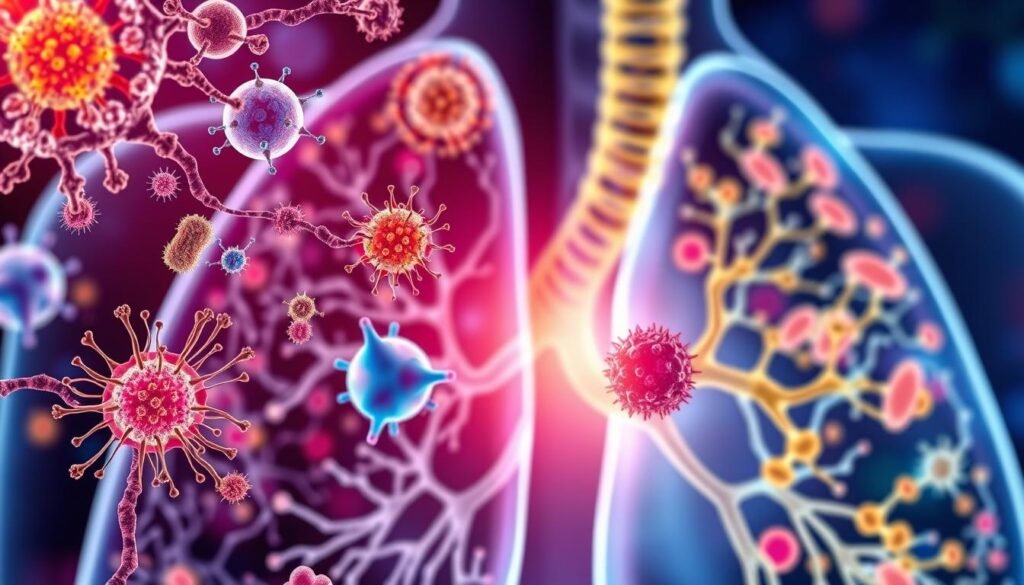Did you know that for stage 1 squamous lung cancer, the five-year survival rate is nearly 65%? This info shows the chance of living longer after being diagnosed. It also shows how important it is to find the cancer early. Squamous lung cancer is a type of non-small cell lung cancer. It accounts for about 25-30% of all lung cancer cases. The survival rates change a lot depending on when the cancer is found.
The American Cancer Society and the SEER database provide the survival rate stats for squamous lung cancer. These stats are crucial for patients and their families as they look at treatment options. These rates consider things like cancer stage, who the patient is, and specific cancer gene changes. Meeting with healthcare experts helps patients make choices based on their situation.
Key Takeaways
- Stage 1 squamous lung cancer has a five-year survival rate of about 65%.
- Survival drops to about 40% for stage 2.
- The survival rate is around 15% for stage 3, while stage 4 falls to about 5%.
- Things like cancer stage, gene changes, and overall health have a big impact on survival rates.
- Getting checked regularly and finding the cancer early are key to better treatment results.
Understanding Squamous Lung Cancer
Squamous cell carcinoma makes up about 30% of all lung cancer cases. It starts in flat cells lining the lungs. Mainly, smoking is to blame, affecting 80% to 90% of patients.
Knowing the signs and risk factors is key for early diagnosis and prevention.
What is Squamous Cell Carcinoma?
This cancer begins in the flattened epithelial cells. It falls under the larger umbrella of lung cancers known as non-small cell lung cancer (NSCLC). People with this cancer often have smoked or been exposed to substances like asbestos and radon.
It can spread to organs like the brain and liver. This makes getting a range of treatments crucial.
Prevalence of Squamous Cell Lung Cancer
Each year, around 55,000 Americans are diagnosed with this cancer. Men are more likely to get it, making up 60% of cases.
The high numbers show how big an issue it is for public health. It highlights the need for actions to cut down lung cancer risks. Despite efforts, squamous cell lung cancer remains a major cause of death from cancer. This shows how important prevention is.
Stages of Squamous Lung Cancer
Knowing the stages of squamous lung cancer is key for choosing the best treatment. It goes from stage 0, with cancer only in one spot, to stage IV, where it has spread a lot. Knowing the stage helps doctors decide how to treat it effectively.
Overview of Staging
In 1977, the American Joint Committee on Cancer (AJCC) started using the TNM system to describe lung cancer stages. This system looks at tumor size (T), lymph node involvement (N), and if cancer has spread (M). The latest guide, the Eighth Edition, was made after studying over 94,000 patients. It helps doctors figure out the stage of lung cancer clearly.
How Staging Affects Survival Rates
The stage of lung cancer at diagnosis greatly impacts how long patients might live. For example, stage IV patients, where cancer has reached far places, often have a tough time. They have only an 8 percent chance of living five more years. But, if cancer has just started to spread nearby, the chance goes up to 37 percent. Catching cancer early usually means better chances of surviving. So, understanding these stages is crucial for seeing how they can affect survival.
| Stage | Description | Five-Year Relative Survival Rate |
|---|---|---|
| Stage 0 | Localized cancer, non-invasive. | Variable, favorable |
| Stage II | Localized cancer with possible lymph node involvement. | Good |
| Stage III | Regionally advanced cancer, extensive lymph node involvement. | Moderate |
| Stage IV (Distant spread) | Metastatic cancer affecting distant organs. | 8% |
| Stage IV (Regional spread) | Regional metastasis to lymph nodes. | 37% |
Current Survival Statistics for Squamous Lung Cancer
Knowing the survival rates for squamous lung cancer helps patients and their loved ones. It shows a five-year survival rate of about 28% across all stages. This fact underlines the need for catching the disease early and starting treatment.
Five-Year Survival Rate Overview
The five-year survival rate for this type of lung cancer changes with the disease stage. When caught early, where treatments work best, the survival rate can go up to 65%. But, for those with cancer that has spread far, the rate drops to 9%. This shows how vital early detection and the right treatments are for better outcomes.
Comparative Survival Rates by Stage
| Stage | Five-Year Survival Rate |
|---|---|
| Localized | 65% |
| Regional | 30% |
| Distant | 9% |
| All Stages Combined | 28% |
The survival statistics offer important insights on what to expect, based on the stage of cancer when diagnosed. Understanding these differences helps patients and families make smart choices about their care and treatment.
Factors Influencing Survival Rates
Several factors deeply affect survival rates in squamous lung cancer. Timely diagnosis is one crucial component. Knowing about these factors helps patients and caregivers manage the condition better.
Impact of Early Diagnosis
An early diagnosis is key to better treatment outcomes. Patients found early often live longer than those diagnosed late. Early detection makes more treatments possible. For instance, early-stage non-small cell lung cancer has a better chance than later stages.
Role of Treatment Options Available
The range of treatment options influences survival too. Treatments like surgery, chemo, and targeted therapies have evolved. As a result, patients now have better survival prospects. Especially those with specific genetic markers may find targeted therapies particularly useful. A patient’s overall health and ability to undergo treatment also matter. Those in good health usually see more favorable results.
| Factor | Impact on Prognosis |
|---|---|
| Early Diagnosis | Increases the likelihood of successful treatment and long-term survival |
| Stage of Cancer | Earlier stages have better survival rates than later stages |
| Treatment Options | Diverse treatments improve management and outcomes |
| Overall Health | Better health facilitates surgery and improves treatment tolerance |
| Performance Status | Higher scores correlate with better survival rates |
Gene Mutation Lung Cancer Prognosis
Gene mutations are key in figuring out lung cancer outcomes. They allow us to create better treatments and predict results. Now, genetic testing is a must-have in lung cancer care. It spots mutations that affect both prognosis and how well treatments work.
Significance of Genetic Testing
Healthcare pros use genetic testing to find specific mutations in lung cancer, like EGFR and KRAS. Catching these early changes the game for treatment plans. For example, those with an EGFR mutation often do well with tailored drugs. This improves their gene mutation lung cancer prognosis. Plus, genetic testing gives patients crucial info, helping them choose wisely about their care.
Common Oncogene Mutations
In non-small cell lung cancer (NSCLC), we often see certain mutations. About 10–15% of U.S. lung cancers have the EGFR mutation. This can lead to treatments that boost survival. KRAS mutations, tied to smoking, and FGFR1, common in smokers with a specific cancer type, are also frequent. Here’s a table of common mutations and their traits:
| Oncogene Mutation | Frequency | Characteristics |
|---|---|---|
| EGFR | 10–15% | Common in non-smokers and women, linked to lung adenocarcinoma |
| KRAS | 25% | More prevalent in smokers, associated with adenocarcinoma |
| FGFR1 | 9–20% | Common in smokers with squamous cell lung cancer |
| MET | Up to 5% | More likely in squamous or adenocarcinoma patients |
| BRAF | Up to 3% | Linked to women, smokers, or adenocarcinoma |
Knowing about these mutations helps doctors tailor treatment. Including genetic testing in care means more patients have a chance at better results.
For extra details on gene mutations and what they mean, look into this resource. It explains the testing and treatment options out there.
Understanding Lung Tumor Biomarkers
Lung tumor biomarkers are key in diagnosing and treating squamous lung cancer. They help spot cancer and track its progress. Knowing about biomarkers lets patients choose better treatments.
Types of Biomarkers in Lung Cancer
Many biomarkers aid in lung cancer care, especially in common types like adenocarcinoma and squamous cell carcinoma. Below are some important lung tumor biomarkers:
- ALK
- BRAF
- EGFR
- HER2
- KRAS
- MET
- NTRK
- PD-L1
- TMB
- RET
- ROS1
- STK11
Biomarker tests look at genetic changes, protein levels, and more. This helps guide treatment plans. For example, some biomarkers suggest targeted therapies to stop cancer growth.
Importance of Biomarkers for Treatment Decisions
Prognostic biomarkers greatly impact treatment choices. Testing can uncover different treatment options. This allows for personalized care for each patient.
Liquid biopsies check blood to track cancer and test treatments. Immunotherapy also depends on biomarkers like PD-L1. Their presence can show if a patient will benefit from boosting their immune response to fight cancer. Biomarker advances improve customized medicine, giving more choices in treatment beyond standard therapies.

Targeted Therapy and Precision Oncology
Targeted therapy is a big step forward in treating cancer. It’s very helpful for those with squamous lung cancer. Instead of using the same treatment for everyone, it focuses on the patient’s unique cancer genes. This means treatment is more personalized. This is what precision oncology is all about. It aims to make treatment fit each person’s specific cancer and genes.
What is Targeted Therapy?
Targeted therapy uses drugs that attack cancer cells without harming healthy ones. These drugs stop cancer cells from growing and dividing. They’re different from traditional chemotherapy, which can affect healthy cells too. Targeted therapies use markers in tumors to hit the cancer more accurately. For example, some drugs work better if your cancer has certain gene changes. This leads to better results for those patients.
Impact on Patient Outcomes
The move towards targeted therapy and precision oncology is good news for lung cancer patients. Studies show that matching treatments to a patient’s cancer genes can lead to longer survival. For lung adenocarcinoma patients, those who get targeted treatments often do better than those who don’t.
New targeted therapies keep making survival rates better. Like, targeting ROS1 fusion genes in tumors can be really effective with the right drug. This shows how much precision oncology can change lung cancer treatment for the better.
| Targeted Therapy | Key Features | Impact on Treatment Outcomes |
|---|---|---|
| Definition | Focuses on specific genetic alterations in cancer cells | Better selectivity leads to improved survival rates |
| Delivery | Administered through pills or infusions | Reduced side effects compared to traditional chemotherapy |
| Examples | EGFR inhibitors, ALK inhibitors, ROS1 inhibitors | Higher response rates noted in genetically matched therapies |
| Future Directions | Continued research into additional oncogenic drivers | Aim for personalized treatment plans for each patient |
Targeted therapy and precision oncology offer new hope. They lead to better outcomes by treating squamous lung cancer more personally and based on genetics.
Advancements in Cancer Genomics
Great strides in cancer genomics are changing lung cancer care. This area’s breakthroughs help fight squamous lung cancer better. By using genetic information, doctors can create personalized treatments for each patient. They look at genetic changes to guess how well treatments will work.
The Role of Genomics in Lung Cancer Treatment
Knowing about cancer genomics is key to new treatments for lung cancer. Targeted therapies can be made to hit specific mutations in a patient’s tumor. This means treatments are more effective and have fewer side effects. Liquid biopsy, like testing for ctDNA, helps catch disease early and checks if treatment is working.
Future Directions in Lung Cancer Research
Research is looking to broaden genomic profiling in lung cancer treatment. This could uncover new targets for therapy and make treatments more tailored. Scientists hope to find drug combinations that work better together. Working with top cancer centers, like MSKCC, is vital for fast breakthroughs. More funding in cancer genomics will push treatment forward and help patients more.

The Role of Lifestyle Factors in Survival
Lifestyle choices are key in squamous lung cancer outcomes. Smoking is especially critical, linked to many cases. Knowing how smoking and other factors affect people can lead to better survival chances.
Smoking and Its Impact on Prognosis
Smoking is the top reason for squamous lung cancer. Almost 90% of cases are due to tobacco. The effects of smoking don’t just stop at causing cancer; they also worsen it. Stopping smoking can really help, making survival more likely. It’s important to support those trying to quit.
Other Environmental Factors
It’s not just smoking; other environmental dangers also play a part. Things like radon, asbestos, and chemicals increase lung cancer risk. Knowing about these risks and avoiding them can help. It’s crucial to reduce exposure to such dangers.
| Factor | Impact on Squamous Lung Cancer |
|---|---|
| Smoking | Up to 90% of cases attributable; worsens prognosis |
| Radon Exposure | Increased risk of lung cancer; common indoor carcinogen |
| Asbestos Exposure | Significant risk factor for lung cancer development |
| Chemical Exposure | Linked to various lung-related illnesses; must be minimized |
Understanding the Limitations of Survival Rates
Survival rates are statistical figures derived from past records. They offer a basic outlook of what to expect but have limitations. Recognizing survival rate limitations is key. This is because they don’t always predict personal outcomes accurately. They overlook the unique situations of each patient.
Why Survival Rates are Estimates
Survival rate calculations use data from large groups. But, they may not capture the details of an individual’s health. Things like health status, age, and life choices impact these rates. For instance, each year, around 222,500 people in the U.S. are diagnosed with lung cancer. However, less than 7 percent of small cell lung cancer patients survive beyond five years. For non-small cell lung cancer, the five-year survival rate is between 11 to 17 percent. These numbers show how patient outcomes can vary widely. It’s crucial to talk with healthcare providers about prognosis individual factors.
Individual Factors That Affect Prognosis
Different elements impact a patient’s prognosis. Among these are genetic mutations and the specific attributes of the cancer, like the tumor mutation burden. For instance, patients with small cell lung cancer who have a high tumor mutation burden may live longer. This underscores the need for care that’s customized to the patient. Talking about individual factors helps patients get a clearer prognosis. Conversations with healthcare experts are vital. They can explain how personal health, the cancer’s characteristics, and new findings from recent studies play a role in survival rates.

Patient Stories and Experiences
The stories of people facing squamous lung cancer are deeply personal. They tell us about struggles with the disease. But they also share victories over medical, emotional, and social challenges. These stories offer hope and lessons for others on the same journey.
Real-life Examples of Survival
Sara Whitlock’s story is one of incredible strength. Doctors only gave her a 3 percent chance to live five years after her stage 4 lung cancer diagnosis. Despite this, she didn’t give up. At 49, Sara fought hard with treatments for her rare type of lung cancer, known as RET fusion-positive.
She joined clinical trials for new drugs, like LOXO-292. These treatments worked wonders for her. Today, Sara shows no signs of cancer, showing the potential of new treatments to save lives.
Karen’s story highlights personalized cancer treatment. She had a type of lung cancer with a specific genetic marker. A surgery called a lobectomy removed cancerous nodes from her lung. Then, she took a targeted drug called Tagrisso to stop the cancer from coming back. Her regular check-ups bring good news: no sign of cancer.
What Patients Wish They Knew
Many patients wish they had known more at the start of their cancer journey. They wanted to understand their treatment options and potential side effects. Clear talks with healthcare providers are essential. They make patients feel safer and more confident.
Genetic testing also plays a crucial role in fighting lung cancer. Many survivors say it helped them find the right treatment sooner. Learning about their unique genetic make-up led to better care. This made a big difference in their treatment success and life quality.
| Patient | Initial Diagnosis | Current Status | Key Insights |
|---|---|---|---|
| Sara Whitlock | Stage 4 lung cancer, age 49 | No signs of cancer | Participation in clinical trials with LOXO-292 |
| Karen | Non-small cell lung cancer, EGFR mutation | In remission | Success with personalized treatment and ongoing monitoring |
Conclusion
Understanding squamous lung cancer is essential for knowing about survival rates and treatments. Genetic mutations are key in determining a patient’s outcome. They show us how special treatments can help patients live longer.
The survival stats reveal how different mutations affect chances of living. This highlights why treatments should be tailored to each person. It makes the case for personalized therapy approaches.
The role of future research cannot be overemphasized in advancing cancer genomics. It helps in creating specific treatments for patients depending on their mutation types. This is crucial for those with dangerous mutations like KRAS. With good patient education, we can look forward to better ways to predict and treat cancer.
When healthcare providers and patients work together, everyone learns more about squamous lung cancer. Being up-to-date on new research and taking an active role in care choices are key. These actions are critical in fighting this tough disease.